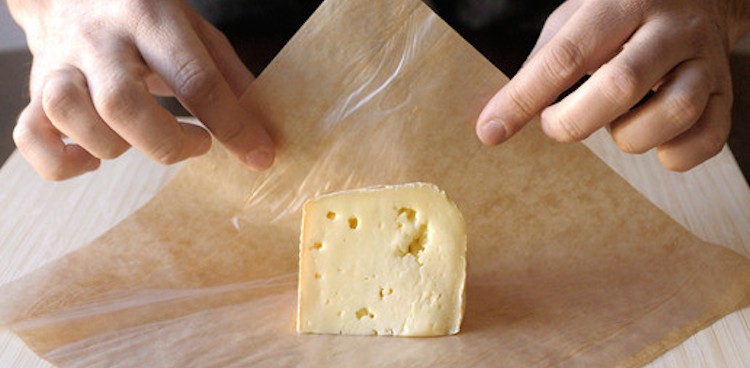
Cheese – it’s one of shelf life’s greatest mysteries. Fortunately, top scientists have ventured into the cheesy cosmos, scoping out new and not-so-new ways to preserve our favorite pleasure-inducing food. But who wants to read scientific papers when they’re long and complicated? It’s much simpler to listen to some age-old wisdom, from Mamma’s kitchen to the world of professional cooking — like for instance, these guidelines for understanding the shelf life out of your cheese, whether it’s hard, soft, stinky, or fresh. Eat safely, friends!
1. Don’t Hate; Refrigerate!
There are relatively few things you should not refrigerate, and cheese – being a dairy product – is certainly not one of them. Cold environments, particularly below 40 degrees Fahrenheit, make it harder for mold and bacteria to grow, keeping your food fresh for longer. As this infographic shows, the shelf life of various foods lasts exponentially longer when they’re refrigerated, and even longer still when they’re frozen. Cheeses can last between two and four months in the fridge, contrasted against one to three months at room temperature for hard cheese and just a few hours for soft. Likewise, both hard and soft cheeses can last six to eight months in the freezer – although we don’t recommend freezing cheese since its moisture content makes it especially vulnerable to freezer burn. Rule of thumb: If you’re not going to cook with it, don’t freeze it. Fresh cheeses should never be frozen, and even with proper refrigeration, they’ll only last you a few days to a week tops. Another helpful tip: separate your mold-ripened cheeses, like Brie or Camembert, from other cheeses, as the spores can leap from one to the other. That certainly doesn’t make for good eats!
2. Wrap it Up Quick!
Wrapping your cheese is a no-brainer (it prevents the cheese from drying out, and protects it from contamination), but what exactly do you wrap it with? That depends on the type of cheese you purchased. By putting plastic wrap over your cheese, you can help it retain its own moisture and keep out additional wetness from other items in the fridge. Cheese paper is another option for harder-style cheeses with a natural rind. Some fresher cheeses will need to “breathe.” For those, like mozzarella and some kinds of feta, keep them in water to maintain a moist equilibrium.

Wrapping your cheese helps maintain its moisture content while also keeping foreign pathogens at bay. / Photo Credit: Markus Wichmann via Compfight cc
3. Not All Mold is Good Mold
Is that a white spot on my Parmigiano? Cut it off, quick! When a cheese is not meant to be moldy, even the slightest hint of foreign contamination can mean trouble. Fortunately, just a little bit doesn’t mean the end for your precious piece. If there’s just a hint of white, that means that mold is just starting to grow and hasn’t yet affected the inside of your cheese. The Dairy Farmers of Canada recommend that you cut at least one centimeter around the contaminated bit and discard it immediately. If your mold starts to turn blue or even green, you might have a bigger problem and should probably throw out your cheese.
For cheeses that are meant to be moldy, you can still run into problems. When the cheese is shipped, it’s usually at its ripest and shouldn’t keep aging after you open it. Therefore, the mold on the rind should stay the same, and there certainly shouldn’t be any on the paste of the cheese. If the paste starts to develop spores, employ the one centimeter rule and ditch that slice. However, if the rind starts to get even moldier – even yellowing and smelling like ammonia, get rid of the whole piece — it could make you sick.
4. The Harder, the Better
Moisture is one of the biggest culprits for mold growth, and it’s for that reason that harder cheeses tend to last longer at room temperature — and in the fridge (just not by as large of a margin). When it comes to cheese storage, keep an especially watchful eye on the softer hunks, since they’ll be the first to go. EatByDate has a helpful resource for gauging the shelf life of your hard cheese, as well as some helpful tips for monitoring that wedge of pecorino on your shelf.

If there’s only one spot of white mold on your cheese, you should be able to cut around it. Anything more and you should throw out the cheese. / Photo Credit: V31S70 via Compfight cc
5. Older is Not Always Wiser
Even though cheeses are often aged at room temperature, an older cheese isn’t guaranteed to last longer than a younger one. A multitude of factors make this true: the aging room’s environment, the enzymes at work inside the cheese, and the protective rind all guarantee that the cheese won’t go stale. However, when a cheese is ripe, the aging process is often halted; therefore, it needs to be stored safely so that it won’t make the consumer sick. Further, when you crack open the protective rind, you’re exposing the paste to outside contaminants, which makes it even more likely that the cheese will pick up bad bugs over time. Statistically, harder cheeses tend to be aged more and will therefore last longer (see #4), but that’s not always true, especially in the case of bloomy-rind cheeses, which have runnier, wetter pastes. Be sure to monitor your elders just as much as your babies.
It’s simply a fact of food that cheese goes stale. That doesn’t mean you should be afraid of trying new and eclectic types – far from it, actually. But, as with all your other dairy items, be on the lookout for anything that could make you sick. You wouldn’t want one bad experience ruining cheese for you. Wrap it, chill it, and keep an eye on it, and you should be good to go. Cheese on!
Photo Credit: Formaticum



